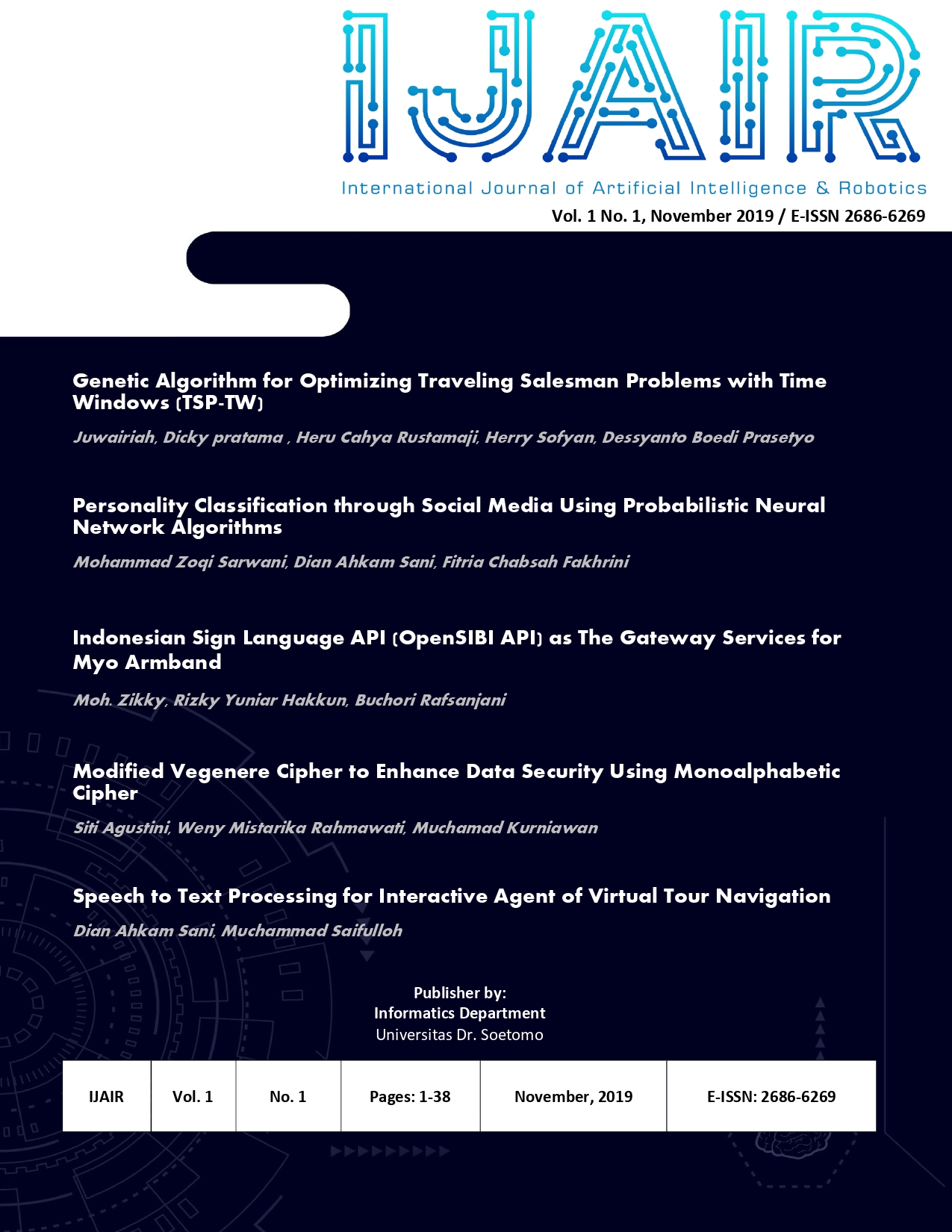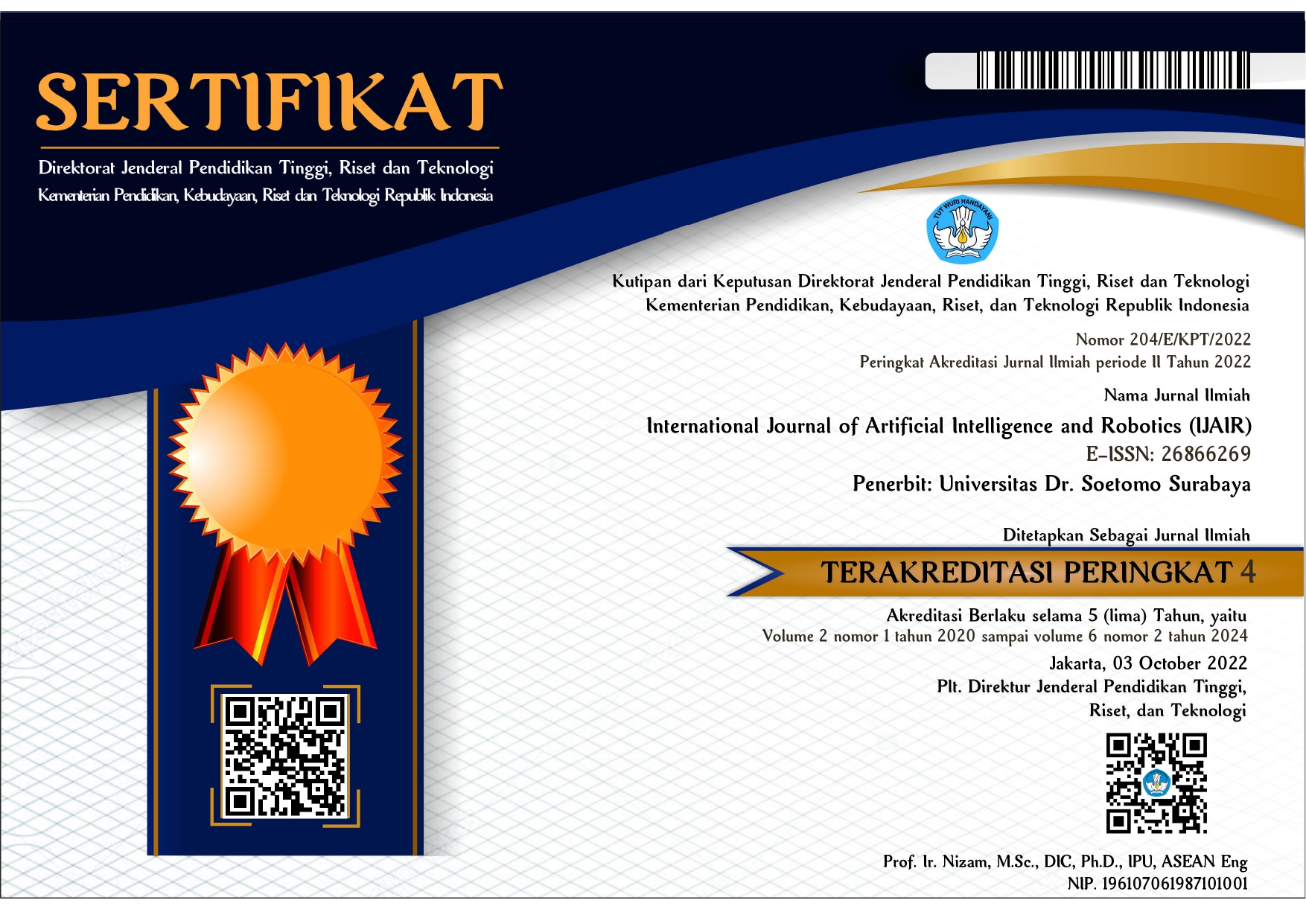Speech to Text Processing for Interactive Agent of Virtual Tour Navigation
 Abstract views: 379
,
Abstract views: 379
,
 PDF downloads: 279
PDF downloads: 279
Abstract
The development of science and technology is one way to replace the method of human interaction with computers, one of which is to provide voice input. Conversion of sound into text form with the Backpropagation method can be understood and realized through feature extraction, including the use of Linear Predictive Coding (LPC). Linear Predictive Coding is one way to represent the signal in obtaining the features of each sound pattern. In brief, the way this speech recognition system worked was by inputting human voice through a microphone (analog signal) which then sampled with a sampling speed of 8000 Hz so that it became a digital signal with the assistance of sound card on the computer. The digital signal from the sample then entered the initial process using LPC, so that several LPC coefficients were obtained. The LPC outputs were then trained using the Backpropagation learning method. The results of the learning were classified with a word and stored in a database afterwards. The results of the test were in the form of an introduction program that able display the voice plots. the results of speech recognition with voice recognition percentage of respondents in the database iss 80% of the 100 data in the test in Real Time
Downloads
References
[2] M. B. Gunawan, “KONVERSI SUARA KE TEKS MENGGUNAKAN METODE HIDDEN MARKOV MODEL,†KONVERSI SUARA KE TEKS MENGGUNAKAN Metod. HIDDEN MARKOV Model, p. 45, 2010.
[3] K. Anam, “Pengenalan suara manusia menggunakan metode,†2013.
[4] F. AN, “Pengenalan Pengucap Tak Bergantung Teks dengan Metode Vector Quantization ( VQ ) Melalui Ektraksi Linear Predictive Coding ( LPC ),†pp. 1–8, 2004.
[5] R. A. SRI MELATI SAGITA, SITI KHOTIJAH, “PENGKONVERSIAN DATA ANALOG MENJADI DATA DIGITAL DAN DATA DIGITAL MENJADI DATA ANALOG MENGGUNAKAN INTERFACE PPI 8255 DENGAN BAHASA PEMROGRAMAN BORLAND DELPHI 5 . 0,†ISSN 1979-276X, vol. 6, no. 2, pp. 168–179, 2013.
[6] M. Irfandy, “Aplikasi Pengenalan Ucapan Dengan Jaringan Syaraf Tiruan Propagasi Balik Untuk Pengendalian Robot Bergerak,†Apl. Pengenalan Ucapan Dengan Jar. Syaraf Tiruan Propagasi Balik Untuk Pengendali. Robot Berger., pp. 1–7, 2004.
[7] and A. A. Z. Sigit Nur Rohman, Achmad Hidayatno, “APLIKASI PENCIRIAN DENGAN LINEAR PREDICTIVE CODING UNTUK BALIK Landasan Teori,†Apl. PENCIRIAN DENGAN LINEAR Predict. CODING UNTUK PEMBELAJARAN PENGUCAPAN NAMA HEWAN DALAM Bhs. Ingg. MENGGUNAKAN Jar. SARAF TIRUAN PROPAGASI BALIK, pp. 151–158, 2012.
Copyright (c) 2019 Dian Ahkam Sani, Muchammad Saifulloh

This work is licensed under a Creative Commons Attribution-ShareAlike 4.0 International License.
Authors who publish with International Journal of Artificial Intelligence & Robotics (IJAIR) agree to the following terms:
-
Authors retain copyright and grant the journal right of first publication with the work simultaneously licensed under a Creative Commons Attribution License (CC BY-SA 4.0) that allows others to share the work with an acknowledgment of the work's authorship and initial publication in this journal.
-
Authors are able to enter into separate, additional contractual arrangements for the non-exclusive distribution of the journal's published version of the work (e.g., post it to an institutional repository or publish it in a book), with an acknowledgment of its initial publication in this journal.
-
Authors are permitted and encouraged to post their work online (e.g., in institutional repositories or on their website) prior to and during the submission process, as it can lead to productive exchanges, as well as earlier and greater citation of published work.















